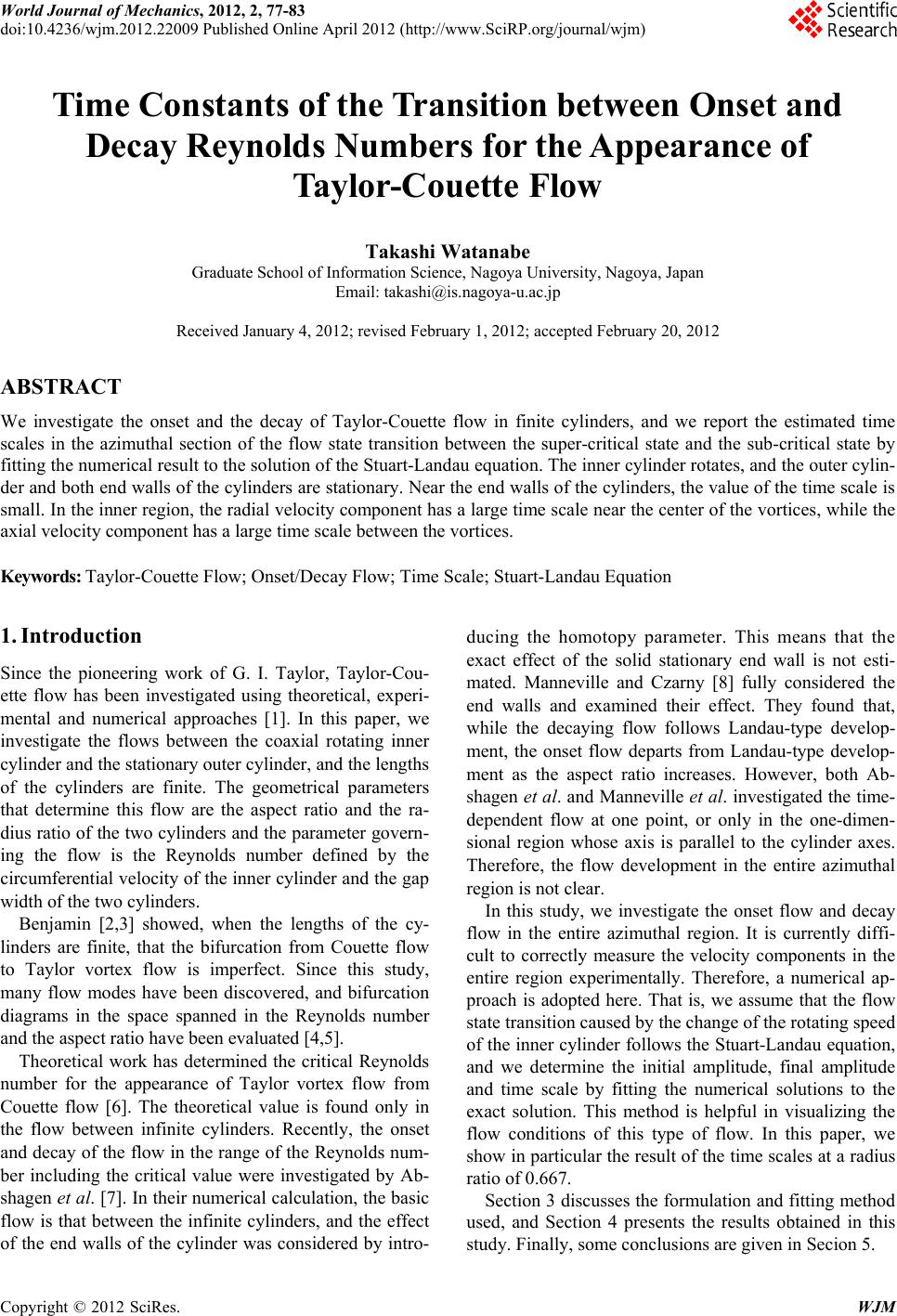
World Journal of Mechanics, 2012, 2, 77-83
doi:10.4236/wjm.2012.22009 Published Online April 2012 (http://www.SciRP.org/journal/wjm)
Time Constants of the Transition between Onset and
Decay Reynolds Numbers for the Appearance of
Taylor-Couette Flow
Takashi Watanabe
Graduate School of Information Science, Nagoya University, Nagoya, Japan
Email: takashi@is.nagoya-u.ac.jp
Received January 4, 2012; revised February 1, 2012; accepted February 20, 2012
ABSTRACT
We investigate the onset and the decay of Taylor-Couette flow in finite cylinders, and we report the estimated time
scales in the azimuthal section of the flow state transition between the super-critical state and the sub-critical state by
fitting the numerical result to the so lution of the Stuart-Landau equ ation. The inner cylind er rotates, and the outer cylin -
der and both end walls of the cylin ders are stationary. Near the end walls of the cylinders, the v alue of the time scale is
small. In the inner region, the radial velocity component has a large time scale near the center of the vortices, while the
axial velocity component has a large time scale between the vortices.
Keywords: Taylor-Couette Flow; Onset/Decay Flow; Time Scale; Stuart-Landau Equation
1. Introduction
Since the pioneering work of G. I. Taylor, Taylor-Cou-
ette flow has been investigated using theoretical, experi-
mental and numerical approaches [1]. In this paper, we
investigate the flows between the coaxial rotating inner
cylinder and the stationary outer cylinder, and the leng ths
of the cylinders are finite. The geometrical parameters
that determine this flow are the aspect ratio and the ra-
dius ratio of the two cylinders and the parameter govern-
ing the flow is the Reynolds number defined by the
circumferential velocity of the inner cylinder and the gap
width of the two cylinders.
Benjamin [2,3] showed, when the lengths of the cy-
linders are finite, that the bifurcation from Couette flow
to Taylor vortex flow is imperfect. Since this study,
many flow modes have been discovered, and bifurcation
diagrams in the space spanned in the Reynolds number
and the aspect ratio have been evaluated [4,5].
Theoretical work has determined the critical Reynolds
number for the appearance of Taylor vortex flow from
Couette flow [6]. The theoretical value is found only in
the flow between infinite cylinders. Recently, the onset
and decay of the flow in the range of the Reynolds num-
ber including the critical value were investigated by Ab-
shagen et al. [7]. In their numerical calculation, the basic
flow is that between the infinite cylinders, and the effect
of the end walls of the cylinder was considered by intro-
ducing the homotopy parameter. This means that the
exact effect of the solid stationary end wall is not esti-
mated. Manneville and Czarny [8] fully considered the
end walls and examined their effect. They found that,
while the decaying flow follows Landau-type develop-
ment, the onset flow departs from Landau-type develop-
ment as the aspect ratio increases. However, both Ab-
shagen et al. and Mann eville et al. investigated the time-
dependent flow at one point, or only in the one-dimen-
sional region whose axis is parallel to the cylinder axes.
Therefore, the flow development in the entire azimuthal
region is not clear.
In this study, we investigate the onset flow and decay
flow in the entire azimuthal region. It is currently diffi-
cult to correctly measure the velocity components in the
entire region experimentally. Therefore, a numerical ap-
proach is adopted here. That is, we assume that the flow
state transition caused by the change of the rotating speed
of the inner cylinder follows the Stuart-Landau equation,
and we determine the initial amplitude, final amplitude
and time scale by fitting the numerical solutions to the
exact solution. This method is helpful in visualizing the
flow conditions of this type of flow. In this paper, we
show in particular the result of the time scales at a radius
ratio of 0.667 .
Section 3 discusses the formulation and fitting method
used, and Section 4 presents the results obtained in this
study. Finally, some conclusions are given in Secion 5.
Copyright © 2012 SciRes. WJM